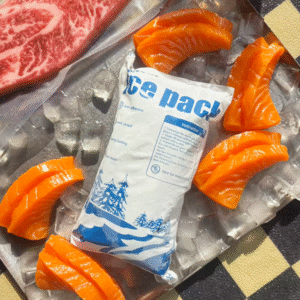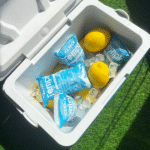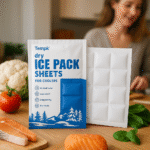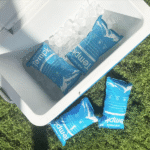Transporting and serving perishable food is challenging when you can’t rely on a refrigerator. UM catering dry ice pack solves this problem by delivering ultra cold temperatures without messy meltwater. Within the first sentences you learn that dry ice sublimates directly from solid to gas, reaching −78.5 °C, which keeps frozen goods intact for up to 48 horas. This guide explains how these flexible dry ice sheets work, why they are ideal for catering services, and how to size, pack and handle them safely.
What makes catering dry ice packs different from regular ice or gel packs? You’ll learn about sublimation, ultra low temperatures and why they prevent soggy packaging.
How do you choose the right size and quantity? We provide simple formulas based on event duration and food type.
What are the best practices for packing and handling? Follow step by step guidelines to keep your food safe and your staff protected.
Which foods benefit most from dry ice sheets? Explore case based recommendations for frozen meats, seafood and dairy.
What new innovations are emerging in 2025? Discover smart logistics, sustainable packaging and automation trends.
Why are catering dry ice packs ideal for catering services?
Ultra low temperatures and dry cooling: Catering dry ice sheets are flexible multi cell blankets filled with high purity carbon dioxide. When the carbon dioxide sublimates (muda diretamente de sólido para gás), it absorbs heat without creating liquid water. This process maintains temperatures as low as −78.5 °C (−109.3 °F), ensuring that frozen foods, such as ice cream or seafood, stay well below freezing throughout transport. Ao contrário dos pacotes tradicionais de gelo ou gel, Gelo seco não derrete na água, so there is no risk of soggy packaging or water damage.
Extended cooling duration: A single dry ice sheet can provide cooling for 24–48 horas, whereas gel packs typically last only 6–12 hours. For multi day events or long distance deliveries, this extended cooling duration prevents last minute temperature spikes and reduces the need to restock cooling agents mid event. Caterers often use the sheets inside insulated containers so the ultra cold environment persists until service time.
Cost efficiency and sustainability: At first glance dry ice may appear more expensive, but preserving food quality reduces spoilage and waste, offsetting the cost. Dry ice is produced from captured carbon dioxide emissions, making it a more sustainable option than using synthetic refrigerants. Adicionalmente, flexible dry ice sheets conform to trays and coolers, meaning you can use fewer packs than rigid bricks or gel packs while still maintaining the desired temperature.
Improved reliability: Because dry ice sublimates rather than melts, it maintains a consistent low temperature throughout its useful life, giving caterers peace of mind. The multi cell blanket design covers the entire surface of food trays or boxes, distributing the cold evenly and preventing warm pockets that could compromise food safety.
The science behind dry ice: sublimation and ultra cold performance
How sublimation works: When dry ice warms up, it transitions directly from a solid to carbon dioxide gas, absorbing latent heat in the process. This is different from melting ice, which first becomes liquid. The sublimation process creates no liquid residue, so your packaging stays dry and food doesn’t become watery.
Comparing temperatures: Regular ice melts at 0 °C (32 °F), while dry ice maintains temperatures around −78.5 °C (−109.3 °F). The extremely low temperature means dry ice can keep goods frozen rather than merely chilled. Gel packs generally keep food near freezing (−21 °C). Choosing between these options depends on whether you need your food chilled or completely frozen.
Dry ice versus regular ice: key differences
| Propriedade | Catering dry ice pack | Regular ice pack | O que isso significa para você |
| Temperatura | −78.5 °C (−109.3 °F) | 0 °C (32 °F) | Gelo seco está muito mais frio, which keeps frozen items solid. |
| Mudança de fase | Sublima em gás CO₂ | Melts to liquid water | Sublimation avoids puddles or soggy packaging. |
| Duração do resfriamento | Até 48 horas | 1–2 hours | Dry ice provides longer cooling, important for multi day events. |
| Mess | Sem água derretida | Leaves water puddles | Cleanup is easier with dry ice. |
These differences show why catering dry ice packs are invaluable for events: they offer significantly longer cooling, maintain lower temperatures, and avoid messy runoff.
Additional benefits and use cases
Besides the performance advantages listed above, dry ice adds a dramatic visual effect when exposed to warm water, producing a low lying fog that can enhance a party’s atmosphere. This makes dry ice packs a unique choice for special events such as weddings, Halloween parties or product launches where presentation matters as much as function.
Choosing the right size and quantity of dry ice sheets
Sizing your dry ice correctly is crucial to ensure food safety and avoid unnecessary waste. The amount of dry ice you need depends on the volume of food, the insulation quality of your container, and the duration of your event. Here’s a straightforward rule of thumb drawn from cold chain logistics guidelines:
Small shipments or short events (por exemplo, seafood platters): planejar 1–2 pounds (0.5–1kg) de gelo seco por 24 horas. This keeps small quantities frozen for a full day without excessive sublimation. For a three hour reception, you can use less, but always round up to avoid temperature spikes.
Larger shipments or multi day events (por exemplo, weddings or festival catering): allocate 5–10 libras (2–5kg) de gelo seco por 24 horas. The upper range is essential for bulky items like meat roasts or whole salmon that require deep cooling.
Specialty shipments: pharmaceutical or biotech products often need 5–10 pounds per 24 hours due to stringent temperature requirements. No entanto, for catering purposes, consider whether the product needs to remain frozen or simply chilled.
When calculating quantity, always account for ambient temperature and container insulation. Hot climates and poor insulation accelerate sublimation and require more dry ice. Por outro lado, high quality insulated boxes or coolers reduce the amount needed.
Mesa: dry ice weight guidelines for catering events
| Event type | Example foods | Duração | Recommended dry ice per 24 h | Notas |
| Cocktail reception | Shrimp cocktails, cheese boards | 3–6 horas | 0.5–1 lb | Use small sheets placed around trays; pre chill food. |
| Wedding dinner | Steaks, seafood platters, sobremesas | 6–12 horas | 2–5 lbs | Combine dry ice sheets with gel packs for salads and desserts. |
| Outdoor festival | BBQ meats, ice cream bars | 12–24 horas | 5–10 lbs | Use insulated coolers; layer dry ice at bottom and between trays. |
| Multi day event | Meal prep for tours or multi day conferences | 24–48 horas | 10–15 lbs | Use multiple layers of dry ice and monitor with a temperature sensor. |
These guidelines give you a starting point. For extra peace of mind, considere a dry ice weight calculator: an interactive tool that asks you about container size, desired temperature and event duration, then suggests the number of sheets needed. Implementing this on your website encourages user engagement and reduces guesswork.
Best practices for packing and handling catering dry ice packs
Packing dry ice correctly ensures maximum cooling efficiency and protects handlers from harm. Below is a step by step approach drawn from cold chain best practices:
Prepare seu recipiente: Use an insulated cooler or shipping box with a tight sealing lid. Pre chill the container by placing it in a freezer or adding reusable gel packs for an hour beforehand. The better your insulation, the less dry ice you’ll need.
Layer at the bottom: Place a layer of cardboard or corrugated plastic at the bottom of the container to prevent the extreme cold from directly touching food packages. Then arrange your dry ice sheets evenly across the bottom.
Add food and separation layers: Stack your food containers on top of the dry ice. Use additional layers of cardboard or foam between food and ice to allow for controlled cooling and easy unpacking. Keep perishable items like meats and seafood closest to the ice, and more resilient items (por exemplo, vegetais) slightly higher.
Preencher vazios: Avoid empty spaces by adding packing materials such as crumpled paper or reusable foam blocks. A tight pack slows down sublimation and maintains a uniform temperature.
Ventilation is critical: O gelo seco libera gás de dióxido de carbono à medida que sublima, que pode aumentar a pressão em um recipiente hermético. Always ensure your cooler has a vent or crack open the lid slightly. Never seal dry ice in a completely airtight container.
Label appropriately: Mark your container with “Dry Ice (E 1845)” and the net weight of dry ice inside. This is not only required for transportation but also alerts staff to handle the package carefully.
Manuseie com cuidado: Always wear insulated gloves when touching dry ice. Use tongs or a scoop to move sheets. Direct skin contact can cause frostbite.
Monitorar temperatura: Use temperature monitoring devices such as Bluetooth or NFC enabled sensors so you can track the internal conditions of your cooler in real time. This ensures compliance with food safety standards and offers reassurance to clients.
Seguindo estas etapas, you minimize the risks of CO₂ buildup, frostbite and food spoilage. Incorporating a short training video or interactive quiz on your website can further engage readers and reduce accidents.
Foods that benefit most from catering dry ice sheets
Not all menu items require the same degree of cooling. The following categories particularly benefit from dry ice:
Alimentos congelados: Products such as ice cream, frozen meats and poultry must remain at sub zero temperatures to prevent thawing. Dry ice ensures they stay solid until consumption.
Frutos do mar: Shellfish and fish are highly sensitive to temperature changes. Even slight thawing can affect quality and safety. Dry ice prevents thawing and bacterial growth.
Produtos lácteos: Queijo, milk and cream require consistent refrigeration. Dry ice helps maintain quality during extended transport.
Hybrid use for less sensitive items: Para frutas, salads or baked goods that only need chilling, pacotes de gel podem ser suficientes. A hybrid approach—using dry ice for frozen meats and gel packs for delicate desserts—optimizes cost and ensures each item is kept at its ideal temperature.
The key takeaway is to match the cooling method to each food’s sensitivity. This not only reduces waste but also demonstrates professionalism to your clients.
Combining dry ice with other cooling methods
Although dry ice is powerful, pairing it with other cooling agents can provide a tailored solution for diverse menus. Por exemplo:
Gelo seco + pacotes de gel: Use dry ice for frozen meats and gel packs for salads or fruit platters. This hybrid technique prevents over cooling items that only need to be chilled and can reduce your overall dry ice consumption.
Gelo seco + water ice: In rare cases where humidity is desirable (por exemplo, keeping vegetables crisp), you might incorporate minimal amounts of regular ice above the dry ice. No entanto, be careful not to trap moisture around products.
Layered approach: Place dry ice at the bottom, then a divider, then gel or water ice. This approach allows each layer to serve its unique purpose without interfering with the other.
Hybrid cooling not only optimizes cost but also demonstrates a tailored approach to catering client needs. To help readers determine which combination suits their event, consider offering a simple quiz that asks about menu items and then recommends a cooling mix.
2025 trends shaping catering and cold chain logistics
Staying ahead of industry trends helps caterers improve service quality and sustainability. Key developments for 2025 incluir:
Smart logistics and temperature monitoring: Real time sensors and IoT devices allow caterers to monitor temperature throughout transport. These systems send alerts if temperatures drift out of range, ensuring immediate corrective action.
Embalagem sustentável: There’s increasing adoption of biodegradable and recyclable materials to complement dry ice cooling. Using recyclable insulation and reusable containers reduces environmental impact.
Automation in cold chain logistics: Automated packaging lines and robotic handling reduce labor costs and errors. For caterers, this means faster preparation and more consistent packing.
Eco friendly dry ice production: Dry ice is created from captured CO₂ that would otherwise be released into the atmosphere. Innovations in carbon capture and storage make dry ice even more sustainable, aligning with corporate social responsibility goals.
By adopting these trends, caterers can distinguish themselves in a competitive market. Highlight your use of sustainable dry ice and monitoring technology in your marketing materials to appeal to eco conscious clients.
Safety considerations: handling dry ice responsibly
Dry ice is safe when handled correctly, but it poses hazards if misused. Siga estas diretrizes de segurança:
Ventilação: Always allow CO₂ gas to escape. Nunca guarde gelo seco em recipientes selados. Leave a small gap in the cooler lid or use containers with built in vents.
Equipamento de proteção pessoal: Wear insulated gloves or tongs when handling dry ice to prevent frostbite.
Labeling and signage: Mark packages with “Dry Ice (E 1845)” and the net weight to comply with regulations and alert handlers.
Keep away from children and pets: Dry ice is extremely cold and can cause injury if touched. Store it out of reach and avoid leaving it unattended.
Disposição: Let remaining dry ice sublimate in a well ventilated outdoor area. Do not pour it down drains or into enclosed spaces, as the gas can displace oxygen and create a suffocation hazard.
Transportation rules: Airlines often limit passengers to 2.5 kg (5.5 Libra) of dry ice in checked baggage, while cargo shipments can allow greater amounts when labeled properly. Always check local regulations before shipping.
Incorporating a printable safety checklist or short training module on your site encourages safe practices and demonstrates commitment to employee welfare.
Frequently asked questions about catering dry ice packs
- How long do catering dry ice sheets last?
Properly packed sheets typically last between 24 e 48 horas. Duration depends on insulation quality, ambient temperature and the amount of dry ice used. - Are dry ice packs suitable for all types of food?
Dry ice is ideal for frozen foods, seafood and dairy. For items that only need chilling (por exemplo, fruits and salads), combine dry ice with gel packs or use gel packs alone to avoid over freezing. - Can I reuse catering dry ice sheets?
Unlike gel-based packs, dry ice itself sublimates and cannot be reused. No entanto, some dry ice sheet products use a superabsorbent polymer core that can be rehydrated and refrozen multiple times. Check the manufacturer’s instructions. - How do I dispose of leftover dry ice safely?
Allow dry ice to sublimate in a ventilated area. Do not throw it in the trash or pour it down drains. Avoid enclosed spaces where CO₂ could accumulate. - Can I transport dry ice on a plane?
Sim, but passenger baggage is usually limited to 2.5 kg (5.5 Libra)de gelo seco, and the package must be vented and labeled. For cargo flights, até 200 kg may be permitted under proper labeling and training. Check airline guidelines before traveling.
Resumo e recomendações
Resumindo, catering dry ice packs provide the ultra cold, moisture free environment needed to keep food fresh and safe for hours or days. They maintain temperatures as low as −78.5 °C, last 24–48 hours, and prevent water damage, making them superior to regular ice and gel packs for many catering applications. To use them effectively:
Match the amount of dry ice to your event’s duration and menu, using 1–2 lbs per day for small trays and up to 10 lbs for large or multi day events.
Follow packing best practices—layer dry ice with protective barriers, preencher vazios, and vent your containers.
Combine dry ice with gel packs when appropriate to tailor the cooling for each menu item.
Adopt smart monitoring and sustainable packaging trends to stay competitive.
By implementing these guidelines, caterers can deliver food that is both delicious and safe, while reducing waste and cost.
Plano de ação
Estimate your needs: Use the dry ice weight guidelines to calculate how much dry ice you need. Consider building a simple online calculator for your clients to use when ordering.
Train your staff: Provide hands on training about safe handling and packing procedures. Encourage them to use gloves and to never seal dry ice in airtight containers.
Upgrade your packaging: Invest in high quality insulated containers and consider adding IoT sensors for temperature monitoring.
Promote sustainability: Highlight your use of recyclable packaging and carbon captured dry ice in marketing materials to attract eco conscious customers.
Mantenha-se informado: Monitor emerging cold chain technologies, such as automated packing lines and biodegradable insulation, and adopt them when feasible.
Sobre Tempk
We are Tempk, an industry leader in cold chain logistics solutions. Our dry ice products, insulated packaging and smart monitoring systems help businesses transport temperature sensitive goods safely and efficiently. With a focus on innovation and sustainability, we continuously develop eco friendly packaging materials and carbon capture based dry ice production. Whether you’re a caterer, pharmaceutical company or biotech firm, we provide tailored solutions that ensure your products arrive in perfect condition.
Chamado à ação: Contact us today for a customized consultation on integrating catering dry ice packs into your operations. Our team will help you choose the right products, calculate quantities and implement best practices so that you can deliver exceptional service.
























